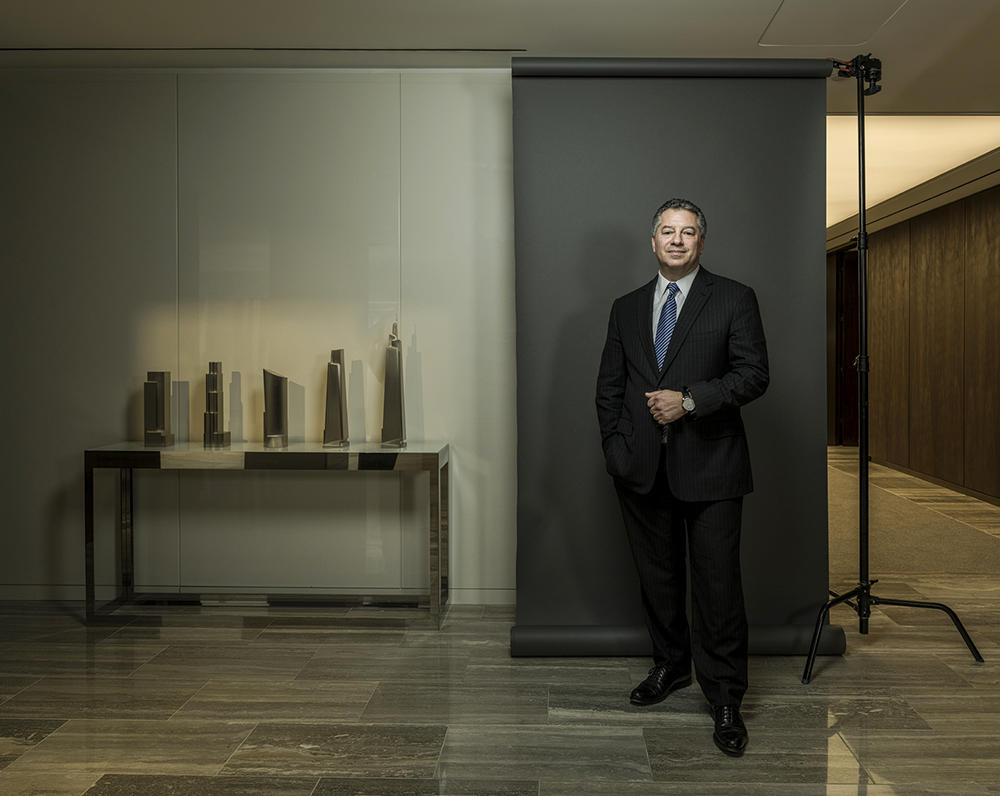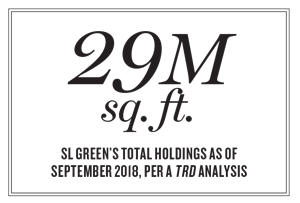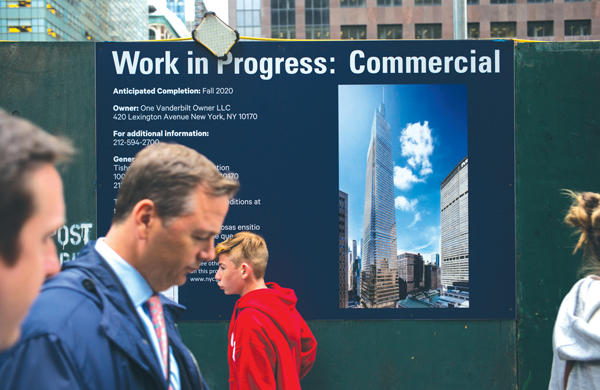Trending
Sizing up SL Green’s big bet
With its stock heavily discounted and New York’s real estate market in limbo, the Manhattan office giant is buying back $2 billion of its shares — but is it rolling the dice?

When it comes to buying New York City trophy towers, SL Green Realty is about as aggressive as they come. But lately the mega-landlord is also spending money on something other than prime Manhattan property — it’s buying up itself.
On the heels of a stock performance slump among real estate investment trusts, SL Green recently kicked off a share buyback strategy that has rarely been done on such a large scale with public companies in the property business.
The REIT, which embarked on purchasing $1.5 billion of its common stock last year, upped that amount to $2 billion this June as the price of its discounted shares continued to fall short of the value of its real estate assets.
SL Green’s CEO Marc Holliday told investors on an earnings call last month that the strategy has made his company “among the most aggressive REITs in the country in terms of share buybacks.”
To facilitate the unprecedented move, SL Green is selling off key chunks of its portfolio at high prices — even as it buys more property and spearheads three big projects, including the ground-up office tower One Vanderbilt. That puts it in a different league than most other New York-based REITs, which have been less active with acquisitions and development projects this year.
Yoron Cohen, an investment sales broker at Colliers International, described that as a good move on SL Green’s part.
As New York’s real estate market grapples with a price correction, “it’s probably more prudent to buy back your own stock than pay high prices for properties,” Cohen told The Real Deal by email. “The correction will bring opportunities [that SL Green] will be well positioned to take advantage of.”
But the buyback strategy is not without risks.
If the price of its shares or the value of its assets declines, SL Green could be left with fewer resources to buy new properties, especially if the REIT takes on too much debt, sources say.
“It’s risky if net asset values go down and they don’t have capital to buy assets,” said one industry source on the condition of anonymity. “Is that going to happen? I don’t know. But that’s always a risk with the stock buyback.”
Strategic selling
Founded by the Brooklyn-born office building investor Stephen L. Green in 1980, SL Green has steadily grown over the years to become New York City’s third-largest property owner, with roughly 29 million square feet on its books, as of September 2018.

And a recent analysis of New York’s top landlords by TRD found that SL Green may generate the most income, with an annual NOI of $1.44 billion across more than 70 properties in the city.
But in a complex whirl of activity to power its stock buyback, SL Green is selling off a handful of assets across the city. Some of the biggest properties the company has sold this year include an office condo at 1745 Broadway to an unnamed Invesco client for $633 million, a Gowanus development site at 175-225 3rd Street to Aby Rosen’s RFR Realty for $115 million, and 1231 Third Avenue — paired with four East 72nd Street properties nearby — to Joe Chetrit for about $144 million.
SL Green also divested a 43 percent stake in its office tower at 1515 Broadway to Allianz Real Estate in a deal that values the property at $1.95 billion, as well as a 50 percent stake in 724 Fifth Avenue to Jeff Sutton for $85.5 million.
And the REIT announced in August that it went into contract to sell a 48.9 percent interest in 3 Columbus Circle to the Moinian Group, which owns the remainder of the property. SL Green expects that sale to close in the fourth quarter and net the company $223 million.
“We have a couple more sales that are in the process, primarily in the suburban portfolio,” Holliday said on last month’s conference call.
In choosing which assets to sell, SL Green opts for properties “that may be somewhat less tax-efficient,” he added. “We’ll typically reinvest those proceeds in other new opportunities, whether it be acquisitions or new development. And by doing that, we’re able to shelter the gain.”
Holliday argued that the REIT’s latest asset deals are consistent with its buying and selling activity over the past 20 years. “Really prior to the buybacks … our stock-in-trade was buying, adding value, monetizing, reinvesting the gains into higher-growth opportunities and moving on,” he said.

Taking stock
SL Green’s share price hit a five-year high of $134 in March 2015 and has since lost about 30 percent of that value.
The REIT’s president, Andrew Mathias, told TRD in a statement that his company raised its buyback target to $2 billion this year “because our discounted stock price continues to be the best investment opportunity we see in the city.”
“We intend to continue the program so long as the stock remains undervalued,” Mathias said.
Attorney Robert Ivanhoe, Greenberg Traurig’s global head of real estate, said this was the first time in his nearly 30 years working with SL Green that he recalled the firm putting such a major focus on buying back stock.
SL Green’s shares were trading at about $93 on the New York Stock Exchange as of Oct. 29, and they have held relatively steady over the past year — hitting a low of $89.46 in February and a high of $106.54 in August. In general, the firm’s stock price has hovered right in between those of two of its biggest competitors: Vornado Realty Trust and Boston Properties, whose share prices have traded around $70 and $122, respectively.
SL Green, which has a market cap of about $8 billion, has purchased 16.5 million of its shares through the program so far at an average price of just under $100 per share, the company’s third-quarter SEC filing shows.
Alex Goldfarb, a senior REIT analyst at Sandler O’Neill, said SL Green’s buyback strategy could help boost its share price and also noted that it gave his firm a more positive outlook on the practice.
“Historically, we’ve not been big fans of buybacks,” Goldfarb said. “But we’ve become more open to them — especially for a company like SL Green, where they’re selling billions of dollars of assets and are putting that money into buying back their own stock. So it’s meaningful.”
Ranjini Venkatesan, a senior analyst at Moody’s Investors Service, said few REITs have pursued stock buybacks to the extent that SL Green has. “Some of the programs I’ve seen so far are more modest,” she said.

SL Green’s One Vanderbilt office tower, slated to open in 2020, is nearly 40 percent leased.
Venkatesan added that it’s tough to predict how successful the buyback program will be. “We’ll see what it does,” she said. “It has to be all taken in context.”
RXR Realty’s Scott Rechler, a longtime partner of SL Green, said the only way the strategy could prove problematic is if the REIT started funding its buyback through debt rather than asset sales.
“When companies borrow to buy back stock, that’s when there’s usually risk, because if the stock doesn’t start to climb, you have a highly leveraged company with less cash,” he noted.
“But [SL Green] has been very disciplined about selling assets and then using those proceeds to buy back stock,” said Rechler, who has worked closely with the REIT since 1998, when his former firm, Reckson Associates, sold it several Class B office buildings. (SL Green later acquired Reckson for about $4 billion in 2007.)
Though its stock buyback has not prompted the firm to stop making new real estate investments, Rechler emphasized that SL Green needs to weigh the merits of every new acquisition against any potential impact to its stock price.
Broker and former mayoral candidate Paul Massey, who launched his firm B6 Real Estate Advisors this summer, echoed those points and noted that REIT stock prices are “really out of whack with reality right now for most of these companies.”
“I can imagine why their own stock is attractive to them,” he said about SL Green. “I don’t think it will hamper their ability to conduct their business and do what they need to do.”
Vested interests
Indeed, SL Green has been far from quiet on the acquisition front of late.
After a long battle between several investors in 2 Herald Square, the REIT acquired the leasehold for the troubled Midtown office building in May. The following month, the company made a push to a buy a controlling stake in the beleaguered HNA Group’s 245 Park Avenue office tower.
 Holliday noted on the earnings call that “2 Herald Park and 245 Park are just two of the examples where we are able to put new money to work in ways that we feel will be highly accretive.”
Holliday noted on the earnings call that “2 Herald Park and 245 Park are just two of the examples where we are able to put new money to work in ways that we feel will be highly accretive.”
SL Green also recently teamed up with RXR to purchase a 49 percent stake in Midtown’s One Worldwide Plaza for $840 million, in a deal that valued the property at about $1.7 billion. The firms purchased their stake in the 1.8 million-square-foot office tower from New York REIT as part of its liquidation sale. At one point, SL Green was rumored to have been a potential bidder for the entire company.
Rechler said the partners will not have that much work to do at Worldwide Plaza, though they’re planning to make some renovations. “We are putting plans together to upgrade the lobbies and entranceways and activate some of the retail,” he said.
SL Green is also planning to build a 35-story mixed-use property at 185 Broadway in the Financial District and redevelop the roughly 1.1 million-square-foot office tower at One Madison Avenue with as much as 450,000 square feet of additional space.
Meanwhile, the REIT is in the middle of building One Vanderbilt, which is slated to open in 2020 with major tenants including TD Bank, the Carlyle Group, McDermott Will & Emery and Greenberg Traurig. Ivanhoe said he expects his firm to move into the office tower in the latter half of 2021.
By this point the REIT has leased nearly 40 percent of One Vanderbilt, and Daniel Boulud is planning to open an 11,000-square-foot restaurant on the tower’s second floor. SL Green financed the $3.2 billion project with a $1.5 billion construction loan from more than a dozen banks, $500 million-plus in equity from the Texas real estate firm Hines and a Korean pension fund, and personal investments from Holliday and Mathias.
While most of SL Green’s competitors in the REIT space have dialed back on their development projects and investments in the Big Apple in 2018, Brookfield Property Partners is one other exception among large publicly traded real estate firms.
The company, which is based outside of New York, recently purchased a seven-building development site for $165 million in Mott Haven, where it’s planning a residential project with 1,300 units, and it struck a 99-year lease with an option to buy at Kushner Companies’ 666 Fifth Avenue, among other deals.
Ben Brown, who oversees Brookfield ’s New York and Boston offices, told TRD in July that while SL Green is heavily focused on buying back shares, his company’s position as a global firm makes it harder to apply the same strategy. “They’re New York City-focused,” Brown said about SL Green. “That’s the only market that they play in. We have $160 billion in real estate assets all over the world.”
Marcus & Millichap investment sales broker Eric Anton said that once SL Green completes its buyback, the REIT is likely to ramp up its investment activity in New York even more. “It’s definitely cyclical,” he said.
But when it comes to new acquisitions, for the time being, SL Green is focused on potential deals that would involve a less competitive bidding process, Sandler O’Neill’s Goldfarb noted.
He cited Worldwide Plaza as emblematic of the type of investments SL Green is on the hunt for. The building’s ownership structure is fairly complex, and a major tenant, the law firm Cravath, Swaine & Moore, may leave in the near future — both factors that could deter many other firms from taking an interest in the asset.
“That’s the type of deal that’s not going to appeal to a broader set of buyers,” Goldfarb pointed out.
“Clearly, anything that’s coming to market in New York is going to attract attention, but they try to do the things that are going to scare some of those people away,” he said.




